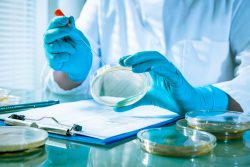 Researchers have cultivated successfully human stem cells that have the ability to renew themselves and repair damage to muscle tissue in mice. This potentially advances attempts to treat disorders that are muscle wasting and muscle injuries in humans.
Researchers have cultivated successfully human stem cells that have the ability to renew themselves and repair damage to muscle tissue in mice. This potentially advances attempts to treat disorders that are muscle wasting and muscle injuries in humans.
To create the stem cells that are self-renewing, the team started with lab grown human skin cells that had been genetically changed to a more undeveloped state where the cells had the possibility of becoming just about any cell type found in the body. These are IPS (induced pluripotent stem) cells and they are combined with a mixture of standard cell nutrients and growth factors that prod them to transform into cells types that are specific.
In the lab, researchers have been able for a long time to alter IPS cells to become a variety of cell types, including brain and skin cells. The more difficult task is being able to change IPS cells to become a cell that self-renews itself for a specific organ.
The team coerced IPS cells to transform into stem cells that are muscle by the use of a nutrient rich blend. Additional research is planned to determine the particular recipe in the future to establish which ingredients might be key to brewing the stem cells that are muscle.
The hope is to be able to make muscle cell therapies to use for muscle wasting diseases such as muscular dystrophy. The team points out that these kind of stem cell treatments are not available at this time.
In proof concept experiments using mice, the team set out to establish where the newly transformed cells settle in living animals and whether or not they could mend tissue that was damaged.
The team showed that after injecting the muscle stem cells into the mice muscles, they moved to an area of the muscles which is called the niche and remained there for over four months. This is where various natural muscle stem cells are normally found.
The team utilized two different techniques to see if the muscle stem cells would mend tissue that was damaged.
In one of the methods, the team transplanted the stem cells that are muscle into genetically engineered mice that were bred without an immune system to keep away from rejection of the transplanted cells. Then they exposed the mice to a toxin that is muscle degrading and also radiation to eradicate muscle stem cells that are already in the mice.
At the area of the radiation damage and toxin in the tissue that was muscle, they found that the transplanted human stem cells developed into mycoblasts. These are a kind of muscle construction cell that will repair damage through fusing together and developing microfibers that look like ordinary muscle. Additionally, they discovered that several of the transplanted human stem cells that are muscle migrated to the niche and behaved like stem cells that are muscle and naturally found in the mice.
In the second method, the team transplanted stem cells that are muscle into genetically engineered mice with a mutation in the dystrophin gene. This results in Duchenne muscular dystrophy which is a wasting disorder in humans and mice.
The team found that the transplanted stem cells that are muscle traveled to the area of the muscle niche. Over many months, tests indicated that the transplanted mice could run twice as long on treadmills than the untreated mice which is a measure of strength of muscles.
The team says that the stem cells that are muscle could possibly be made as therapies for a variety of disorders of the muscles.
The team will continue to study the use of the cells in the mice models of other conditions that are muscle related and their potential for use in trauma, sports injuries and age related loss of muscle.
To view the original scientific study click below:
Human pluripotent stem cell-derived myogenic progenitors undergo maturation to quiescent satellite cells upon engraftment





